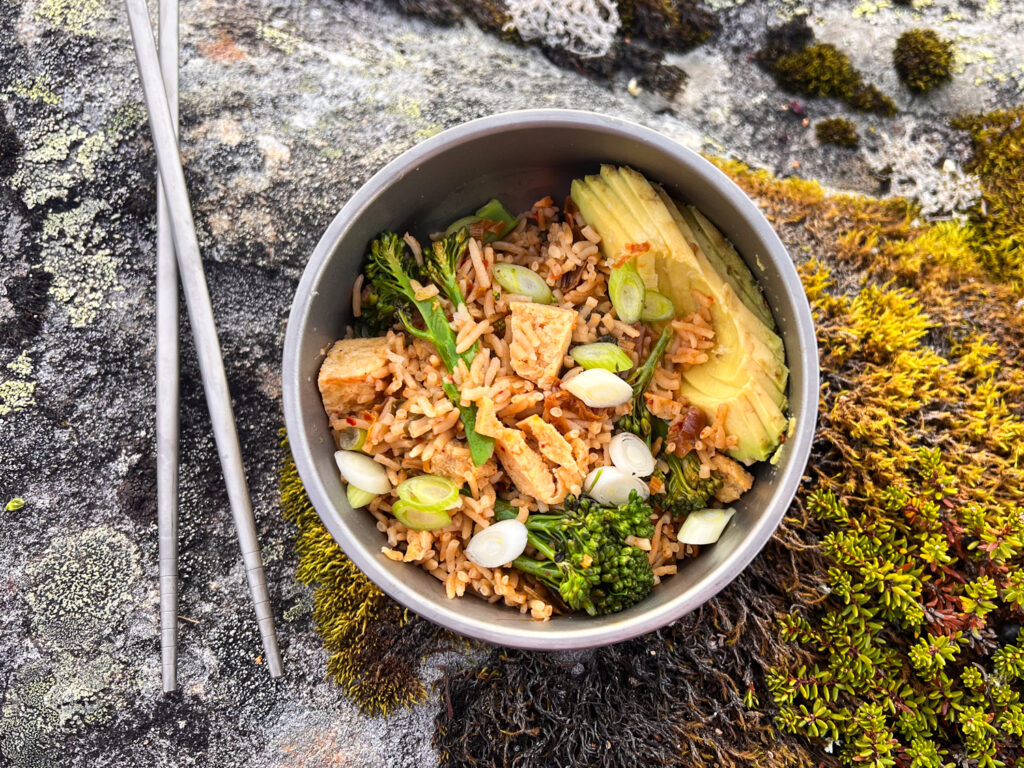
If you’ve read my guide to homemade dehydrated backpacking meals, you may have noticed that rice features in a lot in my trail recipes. And with good reason:
- Rice is a great source of complex carbohydrates and, in its wholegrain form, provides fibre and slow-burning energy.
- When combined with pulses or tofu, the meal becomes a source of complete protein.
- Rice rehydrates super quickly on the trail — a major win when conserving fuel.
- Rice is endlessly adaptable: Mexican, Indian, Korean… like this Kimchi Rice!
Top tip: if you’re new to dehydrating rice, have a look at my post on how to dehydrate rice for backpacking — it’s a total game changer for quick, satisfying trail meals.
FYI this post contains some affiliate links, so if you make a purchase after clicking a link, I may get a small kickback. Thanks for supporting the adventure!
Why you’ll love this meal
This simple Kimchi Rice recipe is inspired by a recipe from Meera Sodha’s brilliant book East — with a few tweaks to make it trail-friendly. It’s quick to make if you’ve got a jar of kimchi and some pre-cooked rice kicking around, and it works beautifully as a dehydrated backpacking meal or a hearty at-home dinner. Meera includes gochujang Korean chilli paste in her recipe. I made this without gochujang and it was still awesome, so don’t let specialist ingredients stop you. If you want extra heat, any kind of chilli flakes will do.
The secret to perfect Kimchi rice (and easy Safe dehydrating)
Rinse the rice thoroughly
If you’re cooking rice from scratch, rinse it thoroughly before cooking. This removes excess starch and gives you perfectly fluffy grains — which taste better and dry more evenly in the dehydrator.
If rinsing rice feels mysterious, see this guide to rinsing rice has a few simple tips for getting it just right (it’s not rocket science).
Dehydrate immediately at 63 °C (145 °F)
You may have been warned about eating leftover rice due to the risk of bacteria. As I mention in my primer on dehydrated rice, dehydrating rice mitigates this risk. The key is to dehydrate your rice soon after it’s been cooked at sufficiently high temperature—above 57 °C (135 °F) is the FDA’s “safe-hot” threshold, but many experts recommend 63 °C (145 °F) as a safer margin. At that higher temperature, you can dry rice reasonably quickly (for example, 3 cups cooked dried in ~4 hours) and safely rehydrate it later.
Optional add-in: Dehydrated tofu
For an extra protein boost, I love adding dehydrated tofu. Here’s my not-so-secret method for getting the best texture tofu that rehydrates almost instantly in boiling water:
- Buy fresh tofu.
- Freeze it.
- Thaw it completely.
- Squeeze out the excess water.
- Cut into cubes and dehydrate.
Freezing creates tiny air pockets that make the tofu spongier and help it rehydrate almost instantly on the trail. I found that plain tofu worked perfectly well with the kimchi rice, but you can also season it before dehydrating if you want more flavour.
👉 Tip: 25g of dehydrated tofu adds about 80 kcal per serving.
Quick Kimchi Rice from Dehydrated Pantry Staples
I know many backpackers keep a store cupboard of dehydrated pantry staples to hand. In which case, take a tip from Trail Recipes and add dehydrated kimchi to your pantry. You can make quick kimchi rice by combining a few base dehydrated ingredients. As a guideline, the following weighs about 120g and contains about 400 Calories.
- 90g dehydrated plain rice (white or jasmine for faster rehydration)
- 2 Tbsp dehydrated kimchi (or more to taste)
- 2 Tbsp dehydrated mixed vegetables (e.g. spinach, green beans, or bell pepper)
- 15g dehydrated tofu (optional for protein boost)
- 1 tsp soy sauce powder (yes it’s a thing!) or ½ tsp salt or boullion powder
- Optional: ½ tsp gochujang powder or chili flakes for heat
- Optional garnish: dried spring onions, toasted sesame seeds, or crushed nori
Kimchi Rice, on The Trail
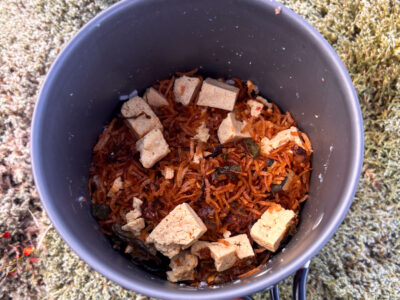
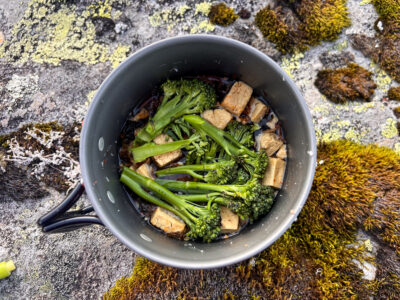
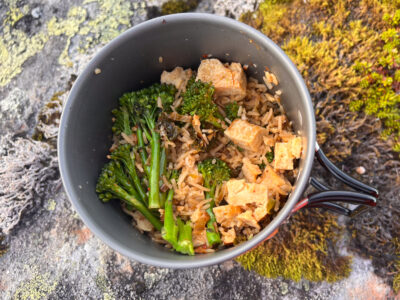
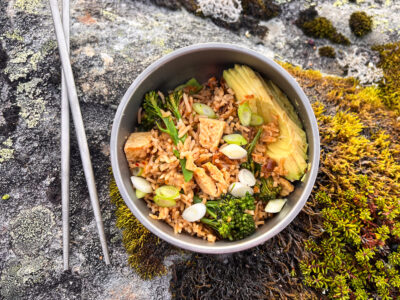
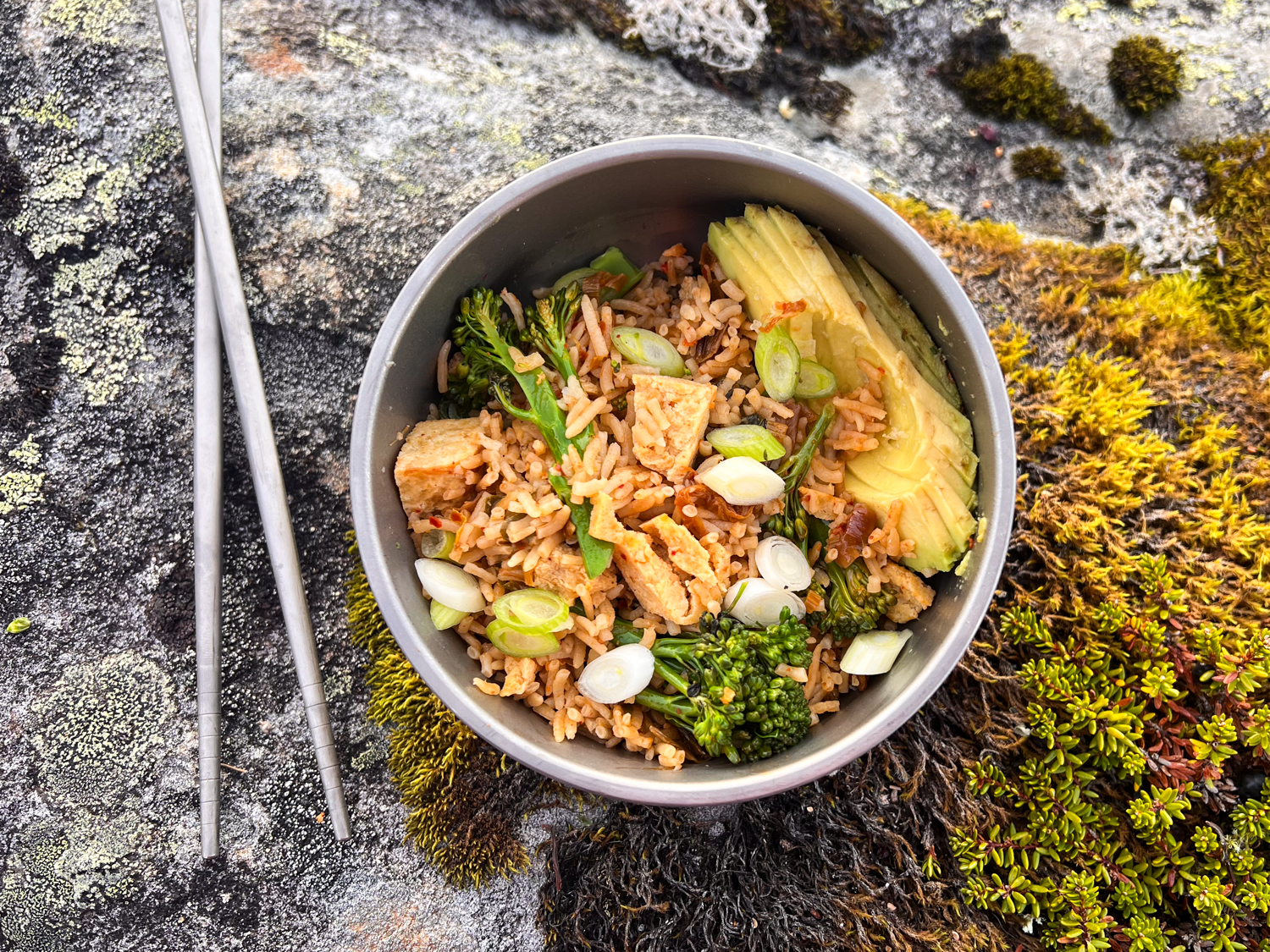
Kimchi Rice – Dehydrated Backpacking Meal Recipe
Ingredients
Method
- Cook the rice: Rinse the rice thoroughly until the water runs clear. Add to a saucepan with 450ml of freshly boiled water. Bring to a boil, cover, and reduce to low heat. Simmer for 15 minutes, then switch off and rest (covered) for 5–10 minutes. Fluff with a fork and let cool. (Alternatively, cook your rice in a rice cooker.)
- Heat the rapeseed oil in a large frying pan. Add garlic and cook for about a minute. Stir in the kimchi (and its juice) and spring onions, and fry for about 5 minutes until most of the liquid has evaporated and things have started to caramelise.
- Stir in sesame oil, soy sauce, and gochujang (if using). Add the rice and mix well, folding in the greens bit by bit until wilted. Taste and adjust seasoning. Let cool.
- Spread the kimchi rice in a thin, even layer on dehydrator trays lined with mesh or parchment.
- Dehydrate at 63°C / 145°F for 4–6 hours, stirring once or twice.
- The rice is ready when it’s completely dry and brittle.
- Let it cool completely before packing (warm rice = condensation).
- Store in airtight containers or portion into freezer bags or vacuum packs. Add tofu if desired.
- Add the rice (and tofu, if using) to a heatproof bowl and just cover with water.
- Toss in some fresh greens like tenderstem broccoli or green beans if you’ve packed any.
- Bring to a boil, then turn off the heat and cover for 5–10 minutes.
- Stir, taste, and if needed, give it another short blast of heat before serving.
- Garnish if you fancy — avocado, coriander, or toasted seeds all work brilliantly.
Notes
Calories: ~360 kcal per serving (plus ~80 kcal if you add 25g dehydrated tofu)
Further Reading
For something similar with a different twist, you might also enjoy my


 Ben Alder: Tour of the Ridges
Ben Alder: Tour of the Ridges
Leave a Reply